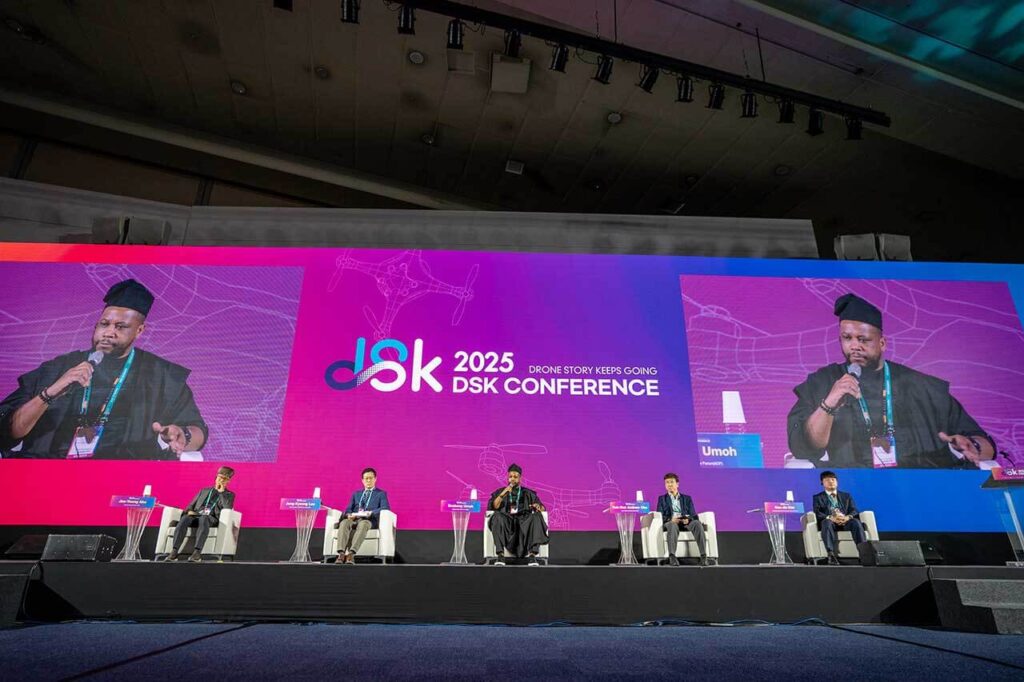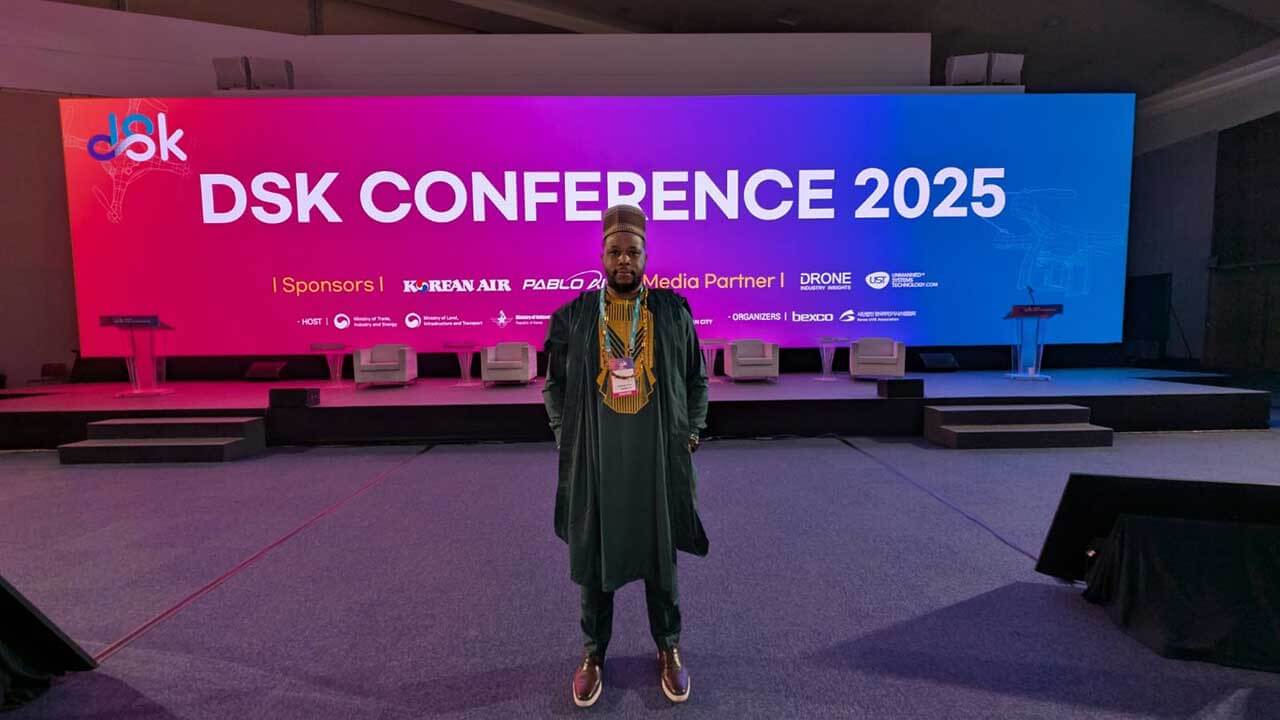By: Eno Umoh, AG Business & Entrepreneurship Ambassador
Asia’s largest drone conference, Drone Show Korea (DSK) 2025, marked its tenth year in Busan with record participation. Often overshadowed by China’s command of the drone market, South Korea’s drone industry proved that it’s a powerhouse in its own right. For those wondering what’s going on with the Korean drone market, here are seven key business and entrepreneurial insights from DSK 2025 – from its featured urban air taxis to global partnerships – that founders and strategists should put on their radar.
1. Urban Air Mobility (UAM): Moving from Hype to Timeline
Korea is turning its UAM vision into concrete plans. While some countries push flying taxi concepts with distant horizons, South Korea’s government and industry appear to be on a more aggressive timeline. The Ministry of Land, Infrastructure and Transport (MOLIT) has a comprehensive K-UAM roadmap targeting initial commercial air taxi routes by the end of this year.
This isn’t just wishful thinking. It’s backed by national “Grand Challenge” trials and real tech demos. For instance, Korean Air (yes, the airline) used DSK 2025 to present an air traffic management system for UAM alongside its future electric vertical takeoff and landing (eVTOL) concepts.
Even city planners are on board. They are updating building codes so that new “smart” buildings come with drone pads and vertiports on the roof. In one pilot project, a major Seoul hospital and city hall are slated to include UAM vertiports for emergency transport and commuting.
Business Insight: South Korea is treating UAM as an imminent urban service, not like sci-fi. Korea is creating the entire ecosystem – from regulations, infrastructure to public buy-in – to make aerial commuting a reality. If you’re building air mobility tech, be ready to integrate with infrastructure and timelines like Korea’s. They’re effectively laying a blueprint for how to launch flying taxi services at scale. If your home market is moving slower, consider partnerships or pilot programs in places like Korea, which are fast-tracking UAM. The first real UAM networks might appear in Seoul’s skies before other global cities. This offers early mover advantages to those involved.

2. UAS Traffic Management (UTM): Building the Highways for Drones
DSK 2025 also displayed a less flashy but critical development – its focus on UTM, essentially the “highway infrastructure” for drones. The Korea Institute of Aviation Safety Technology (KIAST) and MOLIT have been jointly developing the K-Drone UTM system to enable safe, dense drone operations.
At DSK 2025, this UTM focus was evident. Discussions weren’t just about drones themselves, but how to manage many drones flying simultaneously for delivery, taxis and industrial uses. Korean Air’s UAM control system demo is one example. KIAST’s own UTM pilot projects have been underway for years. This equates to real-time drone tracking, geofencing and traffic corridors – all the scaffolding to prevent mid-air chaos. Not many countries can claim an integrated UTM platform in progress, but Korea can.
Business Insight: For drone startups and investors, UTM is a strategic differentiator. Korea’s insistence that “drones can’t scale without traffic management” is a lesson for all. The next big opportunities lie in the software, standards and services to orchestrate large fleets. A fancy drone that can’t fly because airspace is unorganized has limited business value. By investing early in UTM, Korea is making sure its drone companies can scale operations seamlessly. Entrepreneurs elsewhere should plan similarly. Align your tech with emerging UTM standards, or even look to integrate with Korea’s K-Drone system. As global regulators converge on traffic management norms, those who’ve cut their teeth in Korea’s managed skies will have a leg up.
3. AI-Powered Drones Becoming the New Normal
If one theme stood out on the expo floor and keynotes, it was AI – not as a buzzword, but as a capability. One opening keynote by a former military commander-turned-researcher at KARI (Korean Aerospace Research Institute) underscored that AI is driving the next evolution of drones. We’re talking about drones that can identify objects and make decisions on the fly, not just follow pre-set GPS routes.
Several exhibitors showed off AI-driven functionality: from real-time image recognition for inspections to autonomous formation flying. Notably, defense firm LIG Nex1 unveiled an AI-powered surveillance and reconnaissance system for drones that can autonomously analyze imagery and track targets. While geared for military use, this capability has clear commercial spin-offs.
Even the entertainment side demonstrated the state of AI. Korean startup UVify flew an impressive 5,293 drones in one coordinated swarm, an impressive feat of control and reliability.
Business Insight: Drones are quickly evolving into intelligent robots of the sky. For businesses, this means new use-cases – and new competition. A drone service that relies entirely on human pilots can’t compete long-term with one that leverages AI for cheaper and safer automation. If you’re a drone manufacturer, this means investing in AI capabilities now, from computer vision, edge processing to swarm logic and more. Korea’s industry embeds AI into drones from the design phase. This arms their drones with advanced autonomy and makes them more attractive in both civilian and defense markets. As one attendee put it, “In Korea, having AI in your drone is like having GPS – it’s expected.” To stay competitive, treat AI-driven features as the new baseline for drone tech.
4. Regulators Accelerating (Not Stifling) Innovation
One of the most striking advantages on display was Korea’s regulatory environment, a case study in public-private partnership. DSK 2025itself is co-organized by multiple ministries (from Transport to Defense) and even the new Aerospace Administration, signaling top-level government buy-in.
For example, KIAST, the chief aviation safety institute, leads industry growth initiatives. KIAST’s president Ho Won Hwang emphasized the institute’s role in building drone delivery infrastructure and shaping international standards. In practice, KIAST runs national testbeds, certifies new drone models and organized the Korea pavilion for the upcoming XPONENTIAL 2025 trade show in the US.
Meanwhile, MOLIT actively funds sandbox projects like drone delivery trials to remote islands and the UAM Grand Challenge. It is revising laws (e.g. to allow vertiports on rooftops) to pave the way for new services.
Business Insight: Korean regulators view drones as an economic opportunity first, and a risk to mitigate second. They set clear objectives, like becoming a global leader in drones and counter-drone tech, and align policy to help industry meet them. For businesses, having a solid regulatory baseline remains key to success. Korea has that baseline and continues to build on it.

5. Smart Cities Integrating Drones by Design
While many countries are still figuring out how to retroactively squeeze drones into cities, Korea is baking autonomy into its smart city plans from day one. At DSK 2025, we learned about the government’s “Smart Plus” initiative: a plan to build 10,000 smart buildings by 2035 equipped for robots, drones, autonomous vehicles and UAM.
This isn’t just futuristic talk because pilot projects are already in motion. These next-gen buildings will, for example, feature parking areas for delivery robots, internal layouts for indoor drones or service robots and rooftop UAM hubs.
A new hospital building near Seoul will have a designated vertiport for air ambulances (UAM) and drone ports for delivering medical supplies. City governments are identifying routes where drone deliveries make sense, like across water to island communities and congested downtown corridors, and allocating space for them. Busan, the host city, is positioning itself to be a “drone city.” It plans to leverage the tech for everything from coastal surveillance to tourism.
Business Insight: Korea’s holistic approach means drone businesses there can plug into a prepared ecosystem consisting of cities with infrastructure and public acceptance for autonomous tech. For market strategists, it’s a signal as to where urban tech is heading. When buildings and cities actively accommodate drones, opportunities range from vertiport real estate development, maintenance services for drone hubs to integrated data systems that link drones with smart traffic lights. Founders should think beyond the drone itself to the service layer and infrastructure layer. If you’re developing a drone delivery service, for example, Korea’s model suggests working with real estate and city planners early. The future winners might be those who secure rooftop real estate and city integrations now. Also, smart city integration in Korea indicates future exportable models. A Korean-designed “drone city blueprint” could be a hot export to other nations in a few years. Being aware of these trends means you can anticipate and position for when your city starts adopting similar integrations.
6. Collaborating With Africa: The Next Frontier Market
A highlight of DSK 2025 was the strong Korea-Africa connection being forged. It’s not common to see African drone market opportunities discussed at an Asian drone expo. However, Korea is looking outward and Africa’s booming unmanned aviation scene is on its radar. In fact, the opening keynote was delivered by a South African official who spoke about the country’s successful drone programs in agriculture and land management. The pitch was clear: Africa’s drone market is projected to reach $10 billion, and partners are welcome.
As Chairman of the African Drone forum, I also had the opportunity to speak and reinforce this during side sessions. I discussed with KIAST how Korean expertise in regulation and technology could pair with African nations that are rapidly deploying drones in healthcare, logistics and more. African countries like Rwanda and Kenya have been trailblazing with drone corridors and medical deliveries, often leapfrogging legacy infrastructure, a fact not lost on Korean stakeholders.
Business Insight: The takeaway vibe from DSK revolved around mutual learning. Korea can offer tech and training. African markets offer scale and real-world proving grounds. Conversations there hinted at future agreements for drone pilot programs, technology exchange and even co-developed UTM solutions to manage Africa’s airspaces. Business should consider getting involved in these conversations now.
7. Korea Going Global: A Splashdown in Houston
Perhaps the strongest sign that Korea’s drone industry has global ambitions was its Korean delegation to AUVSI XPONENTIAL 2025 in Houston. Rather than just send a few folks with business cards, Korea set up a full Korea Pavilion with 11 leading companies this May.
This effort, led by KIAST, showcased everything from precision navigation systems to drone swarm light shows under one banner. For the U.S. and international audience at Xponential, this put Korea’s top innovators front and center. In short, Korea has stepped onto the global stage with confidence.
Business Insight: Consider what this means: Korean companies like Synerex (GNSS positioning), Vololand (automated drone docking stations), and UVify (swarm drones) were actively courting partners and clients on American soil. The timing is shrewd, as the U.S. industry is currently seeking “trusted” non-Chinese suppliers. Korea’s reputation for quality manufacturing and tech makes its firms ideal partners in the eyes of Western companies concerned about secure supply chains.
Final Insight: Korea Means Business
Drone Show Korea 2025 wasn’t just a tech expo. It was a barometer for where the autonomous aviation market is headed. Korea’s drone ecosystem is aligning all the pieces: innovative startups and conglomerates, a forward-thinking government and global partnerships from Houston to Nairobi.
For the autonomy professional who’s unfamiliar with Korea, now is the time to pay attention. The actionable signals from DSK 2025 are evident:
- UAM is closer than you think
- Airspace management and smart city integration are the new competitive frontiers
- Global collaboration is rewriting the usual East-West playbook.
Whether you’re a founder plotting your next product, an investor scouting for the next big market or a policy wonk trying to forecast industry trends, keep Korea in your strategic calculus. In the race for drone and UAM leadership, it’s no longer just about Silicon Valley vs. Shenzhen. Seoul has entered the chat. And they mean business!
Sources: The insights above were derived from industry coverage and reports on Drone Show Korea 2025, including official releases and expert analysis (Army Recognition, DroneLife, KIAST and MOLIT publications and Autonomy Global field observations). These illustrate the broader trends and specific examples that informed each takeaway.
By: Eno Umoh

